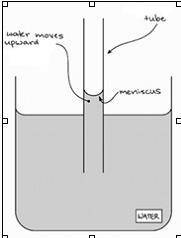
Biology, 16.03.2020 21:05 ravenmcfarlandp07okx
Your biology teacher sets up a lab on the properties of water. You and your partners move to a station which has a thin, glass straw inserted into a beaker halfway filled with water. One of your partner’s asks, “Why is the water in the straw higher than the beaker’s waterline and why is the water on the edges of both the beaker and straw “curved”?
Which of the following best answers your partner’s question?
⦁ The attraction between water and the glass tube (adhesion), as well as on interactions between water and itself (cohesion), force the water in the beaker down and thus pushes the water upwards in the straw giving water in the glass straw the “U” shape at its edges due to Osmosis.
⦁ The attraction between water molecules and the glass walls of the tube (adhesion), as well as on interactions between water molecules (cohesion), force the water upwards giving water in the glass straw the “U” shape at its edges due to capillary action.
⦁ The attraction between water and the glass tube (adhesion) is equivalent to a motorized suction apparatus that sucks up the water with gravity instead of against it.
⦁ The attraction between water molecules and the glass walls of the tube (cohesion), as well as on interactions between water molecules (adhesion), force the water upwards giving water in the glass straw the “U” shape at its edges due to transpiration.


Answers: 1
Another question on Biology


Biology, 22.06.2019 00:30
On a recent expedition to a remote region of northern canada, scientists uncovered skeletal remains from about 100,000 years ago. surprisingly, all the skeletal remains, which included many species from differing biological families and spanned about two thousand years, showed evidence of experiencing temperatures in excess of 1000 degrees fahrenheit (or 538 degrees celsius). which of the following, if true, best explains the apparent paradox between the cold environment and the evidence of the bones experiencing hot temperatures? (a) chemical changes that naturally occur during the process of decay in only one north canadian species produce the same evidence of the species' skeletons being exposed to hot temperatures as the expedition scientists found. (b) a little over 103,000 years ago, a large fire is known to have occurred in northern canada. (c) strong evidence exists that as early as 70,000 years ago, homo sapiens around the world relied heavily on fire to cook animals. (d) in the same expedition and in roughly the same layer of excavation, scientists found rudimentary wood cutting and hunting tools used by early humans.
Answers: 3

Biology, 22.06.2019 09:50
What is the genotype of the male circled in pink? ο χου lo xay xaya done answer was xay
Answers: 2

Biology, 22.06.2019 10:00
With regard to enzymes, key is to lock as a) substrate is to activation energy eliminate b) product is to substrate. c) enzyme is to active site. d) substrate is to active site.
Answers: 1
You know the right answer?
Your biology teacher sets up a lab on the properties of water. You and your partners move to a stati...
Questions

Mathematics, 26.08.2019 08:00


English, 26.08.2019 08:10



English, 26.08.2019 08:10

Social Studies, 26.08.2019 08:10



Mathematics, 26.08.2019 08:10







Chemistry, 26.08.2019 08:10


Mathematics, 26.08.2019 08:10

History, 26.08.2019 08:10



